- Brother support website
- Brother Support for IT Administrators
- I want to apply a common configuration across my entire printer fleet, but retain unique settings for each device.
I want to apply a common configuration across my entire printer fleet, but retain unique settings for each device.
- Use the Mass Deployment Tool's Mapply function to deploy settings to multiple devices using one master set of JSON and CSV (deployment profile) files; no need to prepare a separate JSON file for each device.
- The Mapply function allows you to send and apply a settings file to different devices with just one command by using a deployment profile.
- The Mass Deployment Tool is available only for Windows.
-
Go to the Downloads page on the Brother support website to download the Mass Deployment Tool.
-
Extract the downloaded file into the folder you want.
-
Create and edit the JSON settings file in a JSON-supported text editor.
Click I want to create and edit JSON settings files for more information.NOTE:
- Available schema files are located in the Mass Deployment Tool's schema folder on your computer. The JSON schema files contain all the configurable elements for Brother devices.
- Before you proceed, make sure you have the correct schema file for your model. For a list of available schema files and applicable models, see the README.TXT file in the schema folder. -
When finished, save the JSON file to the location you want.
-
Double-click MassDeploymentTool.exe in the Mass Deployment Tool folder.
-
Click
 in the upper left corner of the screen and select Open Setting File Editor.
in the upper left corner of the screen and select Open Setting File Editor.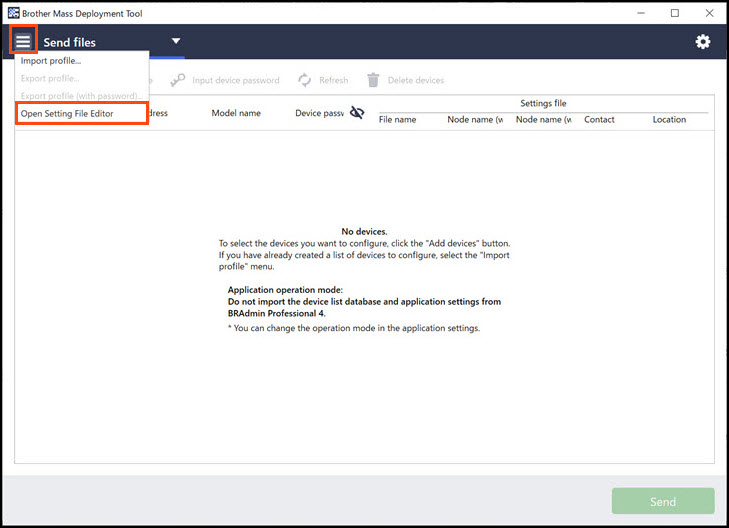
-
Click Open File in the center of the screen and browse to the previously-created JSON settings file.
-
To enable the Mapply function, click the Advanced menu, and then click Create dynamic referencing.
The Brother Setting File Editor pop-up screen appears.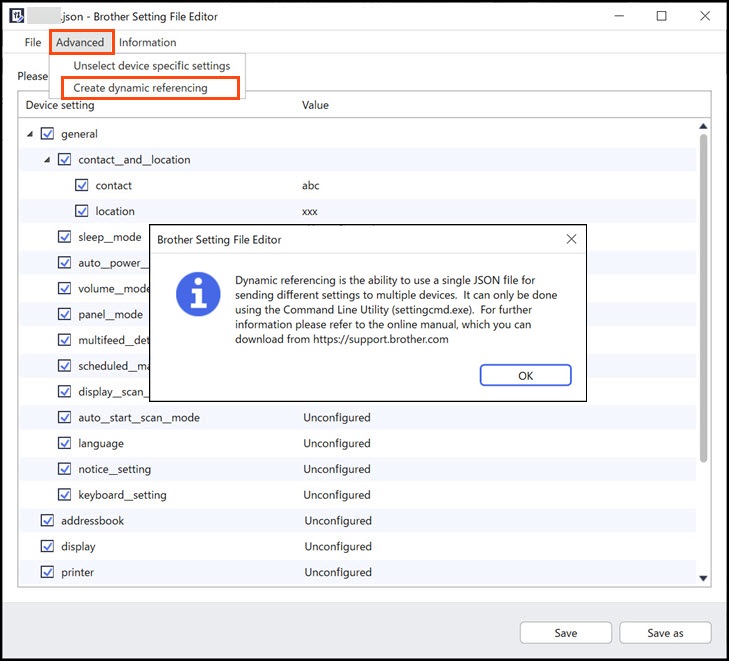
-
Click OK .
-
Specify the Mapply keywords you want in the Dynamic (Mapply) keyword field.

NOTE:
- Mapply keywords are dynamic values specified in JSON files that can be changed depending on the values specified in another file.
- Set dynamic (Mapply) keywords for the settings that are different across your printer fleet. (For example, Contact, Location, etc.)
- Any characters except "#" can be used in the Dynamic (Mapply) keyword column.
-
To save the changes to the existing JSON file, click Save, and then click OK.
NOTE:
When you open the JSON file in a text editor, you will see that all previous data has been replaced with the keywords you just saved.
-
Open the Mass Deployment Tool.
-
Click Add devices to display a list of the devices on your network, select the check boxes of the devices you want to add, and then click Add.
The list of devices you selected appears in the tool's main window.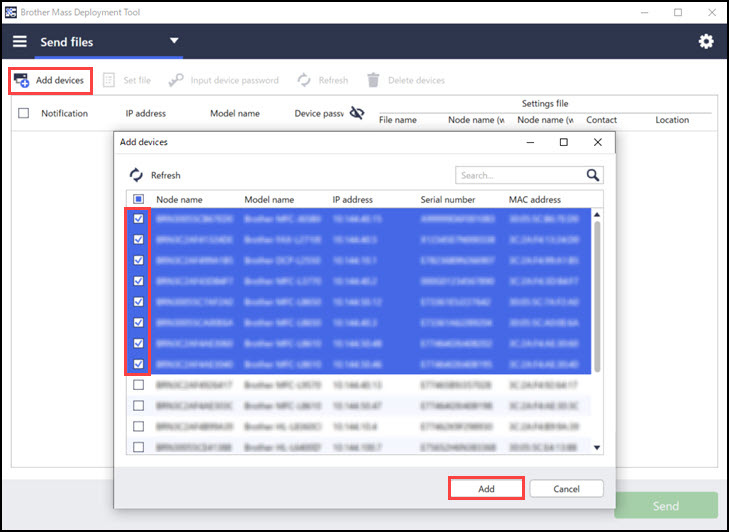
-
Click
 and select Export profile....
and select Export profile.... -
Select the destination folder (use the same folder where you saved your recently-created JSON file), type the file name, and then click Save.
The tool exports the file and saves it in CSV format. -
In the Mass Deployment Tool, click
 , and then click Open Setting File Editor.
, and then click Open Setting File Editor. -
Click Open file, select the JSON file that was created earlier, and then click Open.
-
Click Export..., and then select the Apply dynamic (Mapply) keywords to the deployment profile radio button to add the dynamic (Mapply) keywords to the file you exported in step 15.
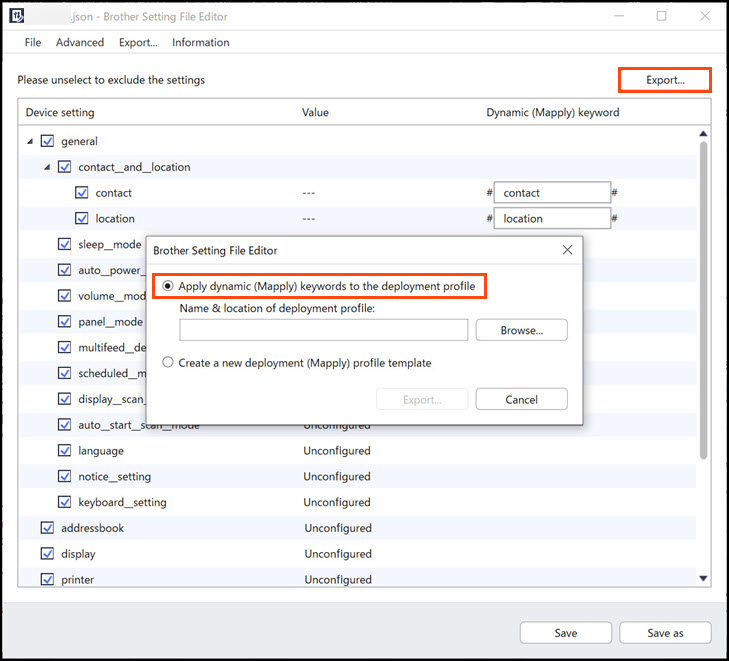
-
Click Browse... to select the recently-created CSV deployment profile, and then click Open.
-
Click Export..., click Save, and then click Yes to replace your existing profile.
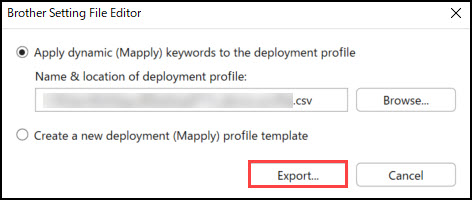
-
Open the CSV deployment profile in Excel.
In the Password column, type the Brother device’s administrator password. -
In the File Path column, specify the name and location of the JSON template file you created earlier.
-
Type the actual setting value information for each device in the User Defined Value (Mapply keyword) field.
-
Save and close the CSV deployment profile.
-
Click Start, and then type cmd.
-
Under Best match, select the Command Prompt app, and then click Run as administrator.
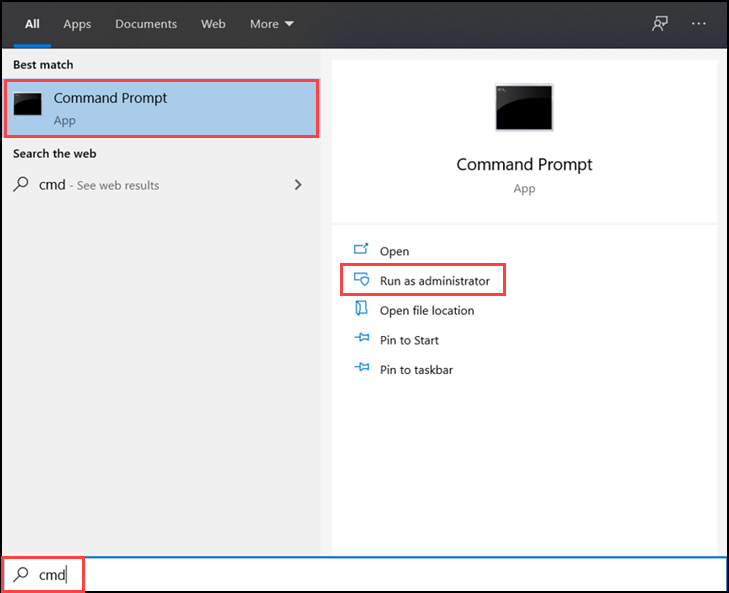
-
Run the settingcmd.exe with the mapply command as follows:
settingcmd.exe mapply --profile name and location of the CSV deployment profile --result name and location of the log file
name and location of the CSV deployment profile Type the name and location of the CSV deployment profile you saved in step 24. name and location of the log file Type the name and location where you want to save the log file.
If the location does not exist yet, the Mass Deployment Tool will create it.Example:
Where name and location of the CSV deployment profile is C:\Brother\Deployment.csv and name and location of the log file is C:\Brother\Log.csvsettingcmd.exe mapply --profile C:\Brother\Deployment.csv --result C:\Brother\Log.csv
NOTE:
- The settingcmd.exe is located in a folder called SettingCommand in the Mass Deployment Tool folder.
- To run the settingcmd.exe file, you must use the cd command to change the path to the folder where this file is located.
- If this is the first time you use the Mass Deployment Tool's command line interface, you must accept the EULA by running the command settingcmd.exe eula --agree.
-
After typing the command, press the Enter key.
-
Wait for the Mass Deployment Tool to complete the deployment.
You can confirm the result for each device in the result file (CSV format).
Download the Mass Deployment Tool and create a regular JSON file
Convert unique settings values to dynamic (Mapply) keywords in the JSON file
Create a CSV deployment file to send unique values to your JSON file
This deployment profile includes information about the device you want to configure.

